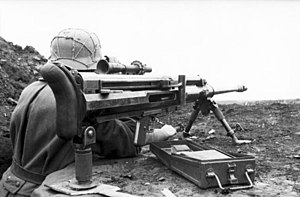| Solothurn S-18/100 (earlier 20x105mmB version) | |
|---|---|
 | |
| Type | Large caliber rifle, Anti-materiel rifle |
| Place of origin |
|
| Service history | |
| Used by |
|
| Wars | World War II |
| Production history | |
| Variants | Solothurn S-18/100, Solothurn S-18/1100 |
| Specifications | |
| Mass | 118 lbs (empty) |
| Length | 85 inches |
| Barrel length | 57 inches |
|
| |
| Cartridge | 20×138mmB (Solothurn Long) |
| Caliber | 20 mm |
| Action | semi-automatic |
| Muzzle velocity | 850 m/s |
| Feed system | 10 rounds |
The Solothurn S-18/1000 20 mm Anti-Tank rifle was a Swiss and German anti-tank rifle used during the Second World War. It was a variant of the earlier S-18/100 with modifications for a higher muzzle velocity, as well as a larger cartridge size. As a result of its large, powerful ammunition the gun had a tremendous recoil, and its size made portability difficult.
History[]
The Solothurn firearms company was owned by the German firm Rheinmetall, who used the Swiss company to manufacture arms which were prohibited for manufacture by any German firm under arms limitations imposed at the end of the First World War.
In 1940–1941 the US Army considered adopting the Solothurn S-18/1000. The weapon was standardized for limited procurement as 20mm automatic gun T3. In spring 1941 the Solothurn was tested against the .90-cal. T4 automatic gun. Although less powerful, the Solothurn was also less bulky and complicated and was found more suitable for Army use. The plans were to acquire an order of 50 pieces and later to produce the weapon in the US. However, long contract negotiations resulted in abandonment of the planned purchase.[1]
Specifications[]

- Service History: Used by Italy, Hungary, Finland Germany and Netherlands, during World War II and Finland's Continuation War.
- Overall length: S18-1000 and −1100 85". This could vary due to a number of optional muzzle brakes used for different projectile weights.
- Barrel Length: 51" muzzle brakes length: 1 hole brake 1", 4 hole 4", 5 hole 5". The brake adds to the overall length of the barrel when installed.
The brakes are changed depending on the recoil force of the rounds being fired. Lighter projectiles require less recoil reduction from the brake to allow the action to cycle. Therefore the one hole brake is used for firing High Explosive projectiles which are much lighter than the Armour Piercing variety. The AP projectiles require the 5 hole brake.
- Weight: S18-1000 and −1100 118 lb empty with Magazine ( 4 lb)
- Cartridge: S18-100 20mmX105B, S18-1000 and −1100 20×138mmB. The B indicates a "belted" round which headspaces on the belt rather than the shoulder, rim or mouth of the case
- Caliber: .818" or 20.5mm (bore diameter is larger than the land diameter of 20mm or .78")
- Action: Recoil operated semi automatic for the S18-100 and S18-1000. The S18-1100 was select fire recoil operated.
- Magazine capacity: S18-100 5 or 10 round, S18-1000 and −1100 10 round standard but the weapon could use the 20 round magazines from the Flak 30 anti-aircraft gun.
See also[]
- L3/35, for the "L3 cc" anti-tank (controcarro) tank destroyer
Notes[]
- ↑ Zaloga, Delf – US Anti-tank Artillery 1941–45, p 7.
References and external links[]
- Zaloga, Steven J., Brian Delf – US Anti-tank Artillery 1941–45 (2005) Osprey Publishing, ISBN 1-84176-690-9.
- Photos of the Solothurn S-18/1000
| ||||||||||||||||||||||||||
| ||||||||
The original article can be found at Solothurn S-18/1000 and the edit history here.